How the Staffing Industry Is Adapting to the Human Cloud (And Why You Should Too)
authors are vetted experts in their fields and write on topics in which they are extremely knowledgeable. All of our content is peer reviewed and validated by world-class professionals.

- Why Uber laid the groundwork for new professional working models.
- How staffing providers are adjusting to leverage new talent pools.
- The socioeconomic factors inciting the drive toward new talent models.
- Critical distinctions between contingent, gig/freelance, and on-demand talent models.
- Four tips for working with a gig or on-demand workforce.
- Visit Staffing.com's homepage for more.
When Uber launched its app for the first time, people suddenly had the power to hail a ride with a single tap. Since then, the consumerization of technology has skyrocketed. We use single platforms to have food delivered, find flights and hotels, even hire someone to magically assemble IKEA furniture for us. Tech paved a direct path between consumer and service provider in unprecedented ways.
Since then, different talent platforms emerged and successfully introduced this concept to professional services, allowing skilled independent workers to showcase their capabilities and seamlessly connect with clients. The doors of opportunity swung wide open, both for talent and those seeking to engage the human cloud.
Freelancing now has the potential to become a lucrative career—so much so that 97% of freelancers wouldn’t “consider returning to traditional work.” Lots of talent are choosing the desirable flexibility freelancing offers over the stability of full-time employment. This creates a fresh pool of talent but presents challenges to engaging with it. The staffing industry is pivoting strategies in response.
Strategic Adjustments in the Staffing Industry
The staffing industry has been responding to this shift by growing its supplies of independent talent. Just as tech revolutionized car rides, similar tech solutions are upending the way companies find talent. Staffing Industry Analysts’ (SIA) North America Staffing Company Survey 2019 found that one in eight staffing firms are either partnering with a human cloud service or own or have invested in one. Another 34% were “considering building, acquiring, or partnering [with a human cloud service] over the next 2 years.”
Another SIA report—US Gig Economy – 2019 Edition—sheds further light on the state of human cloud workers. Human cloud spending alone reached $126.3 billion globally in 2018, and SIA President Barry Asin says one in five US workers at large companies are contingent workers. “A comprehensive talent strategy for forward-thinking organizations must embrace the gig economy,” says Asin.
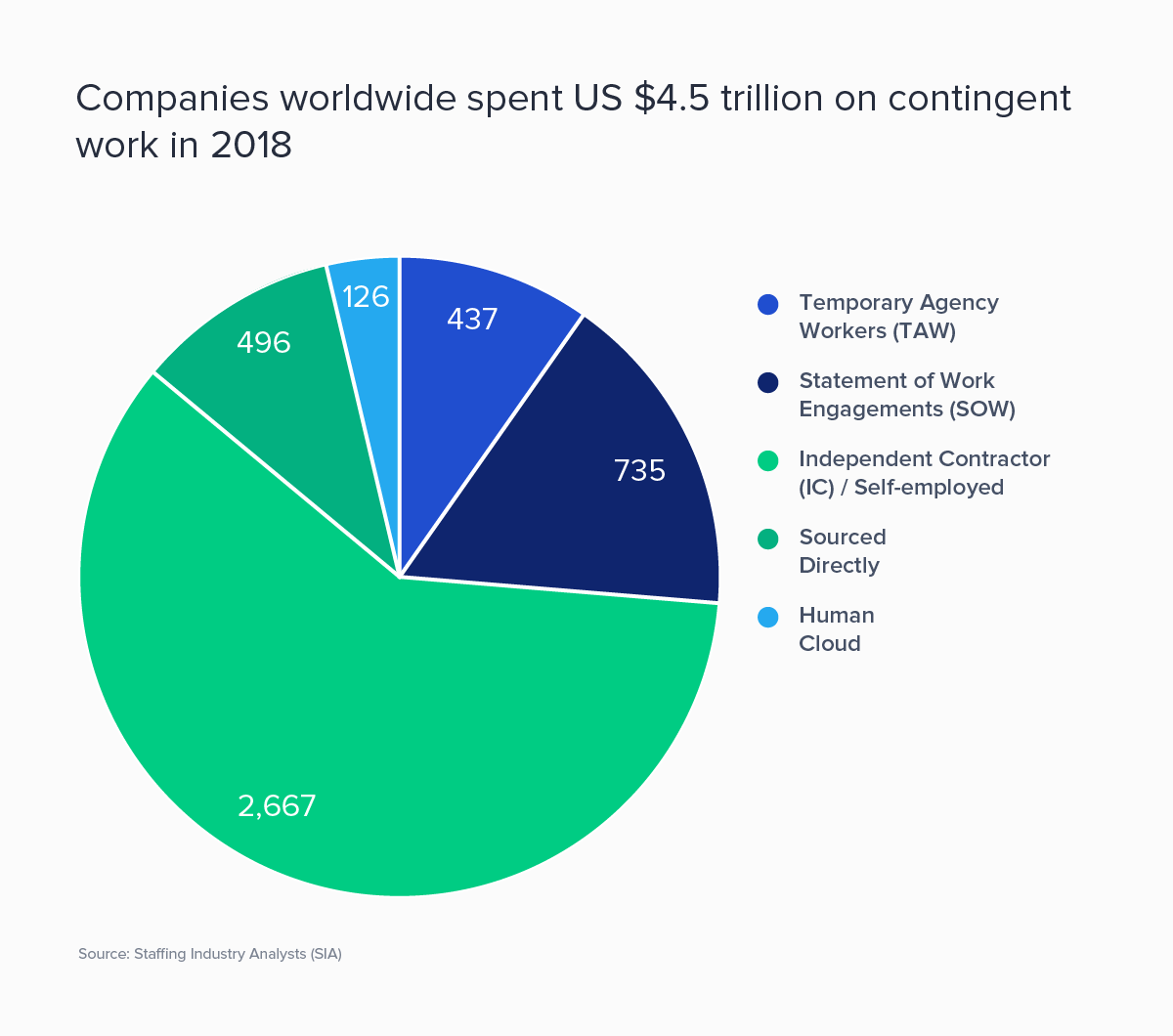
The enormity of global spending on talent solutions reveals just how quickly the workforce landscape is shifting. The way work gets done is being critically redefined, as is the way organizations define and enact a comprehensive talent management strategy.
Social and Economic Drivers
The skills gap is more prominent than ever, especially with US employment the lowest it’s been in five decades. That’s just one of the larger forces spurring this shift to new talent models.
John Healy, Vice President and Managing Director of the Office of the Future of Work at Kelly Services, says that consumer trends are also behind the drive toward new talent models beyond the contingent workforce. What consumers expect and emphasize—real-time interactions, for example—are now being modeled in the workforce. The result is increased pressure for organizations to become employee-centric and create environments that help talent realize their personal purpose. “It’s not all about the purpose of organization, it’s about aligning with your values and what you’re trying to do along the way,” says Healy.
With the shift in worker-employer engagements comes the need to adjust policy and protection for all parties. California is currently addressing the holes in state policy that leave employee or employer rights too vague to be effective. Legal and policy wars are the natural consequence of these shifts—the “figuring out” in progress.
Contingent, Gig, and On-demand—Critical Distinctions
Over the course of a few years, myriad terms have been used to describe engagements with non-full-time employees, the three most prominent being: contingent, gig, and freelance/on-demand talent.
This is new territory, and it can be rife with misunderstandings; here’s what distinguishes each of these critical workforces.
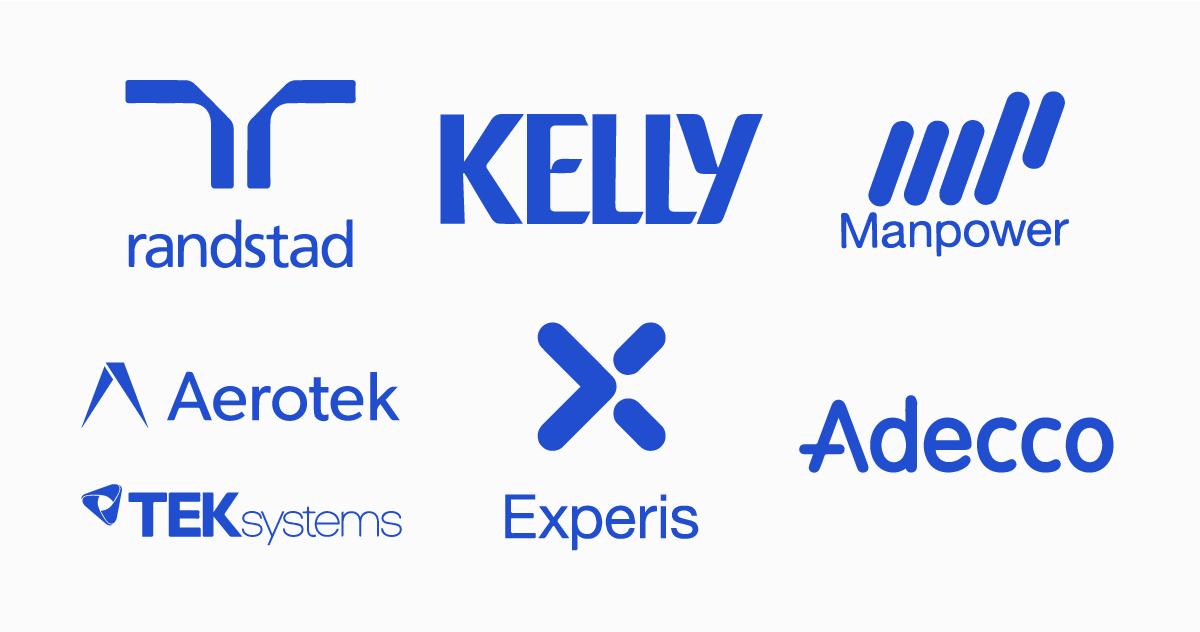
Contingent Talent: A Bucket Term for Temporary Work Models
Contingent workers are defined as freelancers, independent contractors, consultants, or other outsourced and non-permanent workers who are hired to fill an organization’s talent gap temporarily or on a per-project basis. They can be remote or local and are sourced based on the company’s relationship with a staffing or vendor firm in the staffing industry.
There are many different iterations of contingent work, the most common being staff augmentation. Ultimately, the type of work depends on the level of skill desired, if the work is skill- or task-based, how quickly the talent is needed, and whether the talent needs to be based locally. Companies that engage with the contingent workforce often build strong relationships with various types of vendors in the staffing industry: traditional providers, boutique firms, or master vendor staffing providers.
These models allow quick adaptation to the peaks and valleys of a rapidly changing landscape, fulfilling a general talent function that allows an organization to flex its workforce to meet swings in market shifts and organizational initiatives. The model can also act as a bridge to hire, effectively creating a placeholder while a permanent team is developed. Contingent workforce teams can be used to spearhead or test-drive a new initiative and seek competitive advantages.
Contingent is ultimately an umbrella term for the next two concepts we’ll clarify: gig work and freelance/on-demand talent.
Gig Platforms: Enabling Standardized Services
Gig work is best defined in terms of the relationship between client (hirer) and company. The platform or company/brand is the differentiator, not the talent. Uber and Lyft are common examples. With the push of a button, anyone can gain access to a clean car and a safe ride. The same concept extends to a whole host of other services too: virtual assistants, designers, musicians, copywriters, project planners—you name it.
Gig workers maintain a relationship with the platform, rather than their clients. Ultimately, they are beholden to the platform they freelance through, which manages payment, legal agreements, and other aspects of the work. They can also be accessed from anywhere in the world (gig work is almost always enabled by remote work)—hence, “human cloud.”
Though a gig worker can be synonymous with a freelancer, the way they typically engage in work can be quite dissimilar from other models in that their work is based on a general skill. Hundreds of designers may compete for a single project—like designing a logo—on a given platform, for example.
What gig platforms do not offer is a high level of specialized or guaranteed expert-level skill and a high-touch, curated talent selection process. It’s up to the client to vet freelancers and initiate contact. The platform is simply a place for accessing talent from the human cloud and a safeguard in case the partnership goes south (the effectiveness of that safeguard is platform-dependent).
That’s where on-demand staffing comes in.

On-demand Staffing: Expert Specialization
In a gig model, the platform is the differentiator. In the case of on-demand staffing, the platform is the enabler and the talent is the differentiator. These models eliminate the need to go through a third-party or staffing provider, offering curated, vetted talent pools that offer qualified talent as-needed.
On-demand talent are highly skilled talent hired through online platforms which curate the talent from the human cloud so they can be matched and deployed as fast as possible. They are often remote-based; they intentionally choose the flexibility this offers. Companies hoping to leverage on-demand capabilities need to be able to offer remote accessibility as a prerequisite.
Because organizations engage these models when they want the very best talent, speed and efficiency are paramount. On-demand staffing brings irreplaceable value to a team since providers in these models work closely with organizations to offer the best fit for the project at hand. With the ability to assemble highly skilled teams rapidly in this way, organizations can take on challenges and initiatives with unprecedented agility and expertise.
Here are some key differences between these working models.
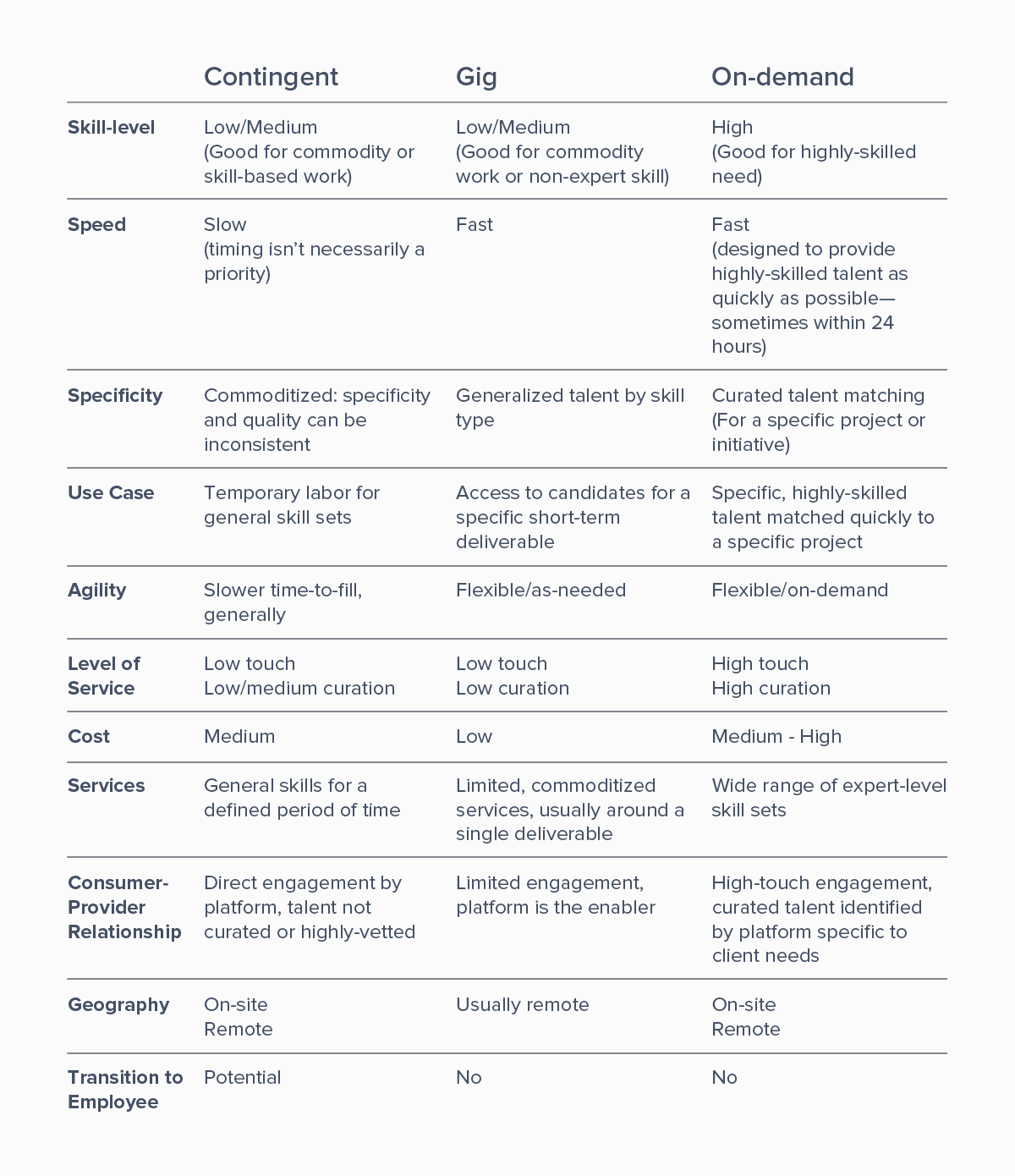
Tips for Working with the Human Cloud
Tip #1: Divide the Work with Gig Models
When engaging with gig platforms, talent are often engaged around a single deliverable—a piece of content, a suite of brand designs, etc. The flexibility can be revolutionary for the organization, but only if it has prepared its projects accordingly. When hiring a worker to do a specific task within a team, that task must be clearly defined, somewhat autonomous, and easy to “brief” the talent in so they can get started. Breaking down large projects into manageable parts allows tasks to be efficiently delegated, and with gig work, it’s all about delegation.
Paul Estes, former Microsoft leader and current Editor-in-chief of Staffing.com, says these tasks “need to have a well defined expected outcome and a reasonable timeline.” Equipping talent with clear expectations and just enough background knowledge is essential. Estes emphasizes the importance of sharing information typically inherent within an organization, such as brand guidelines or process documentation standards.
Projects handed over to gig talent need a higher level of clarity than those kept strictly in-house, and so require thoughtful organization—even before talent is procured.
Tip #2: Optimize for the Speed of On-demand
When it comes to matching talent, on-demand staffing providers measure time in days, not weeks. The speed of delivery can be revolutionary for an organization that needs an expert fast, but only if it maximizes the speed at which that talent is incorporated into the organization.
Traditional hiring processes are littered with time-sucking barriers. For instance, contracts typically involve the employer, employee, and staffing agency, creating unnecessary back-and-forth. On-demand platforms provide matching services rather than contract models (like with a traditional staffing agency), but default contracts assume the staffing provider will take responsibility for their employee’s work. On-demand staffing platforms guarantee a type of skill, not ownership of the products performed; the talent are experts in their own right, and the onus is on them. Contracts need to be altered to reflect this and allow on-demand talent to onboard fast.
Additionally, an organization’s vendor management system can hinder a quick turnaround if they haven’t been adjusted to meet on-demand capabilities. Organizations can either adjust the internal system to support this new type of provider or create a new system that strengthens the agility and speed of on-demand staffing procurement.
Ultimately, the speed of hiring on-demand talent rests on its adoption within departments and teams. A strong change management program will help full-time employees understand the reasons, benefits, and expectations of this new type of talent. Necessary buzz and excitement can be generated from face-to-face interactions with service providers—evangelists throughout an organization can influence positive changes and lead a seamless adoption.
On-demand talent are eager to hit the ground running, but they can only do so if a company’s systems and culture are ready for them.
Tip #3: Cheap Talent Isn’t Quality Talent
Based on the results in Toptal’s 2019 State of the Remote Workforce report, “depth of talent expertise” and “breadth of talent expertise” are among the most common metrics by which hiring managers measure on-demand staffing providers.
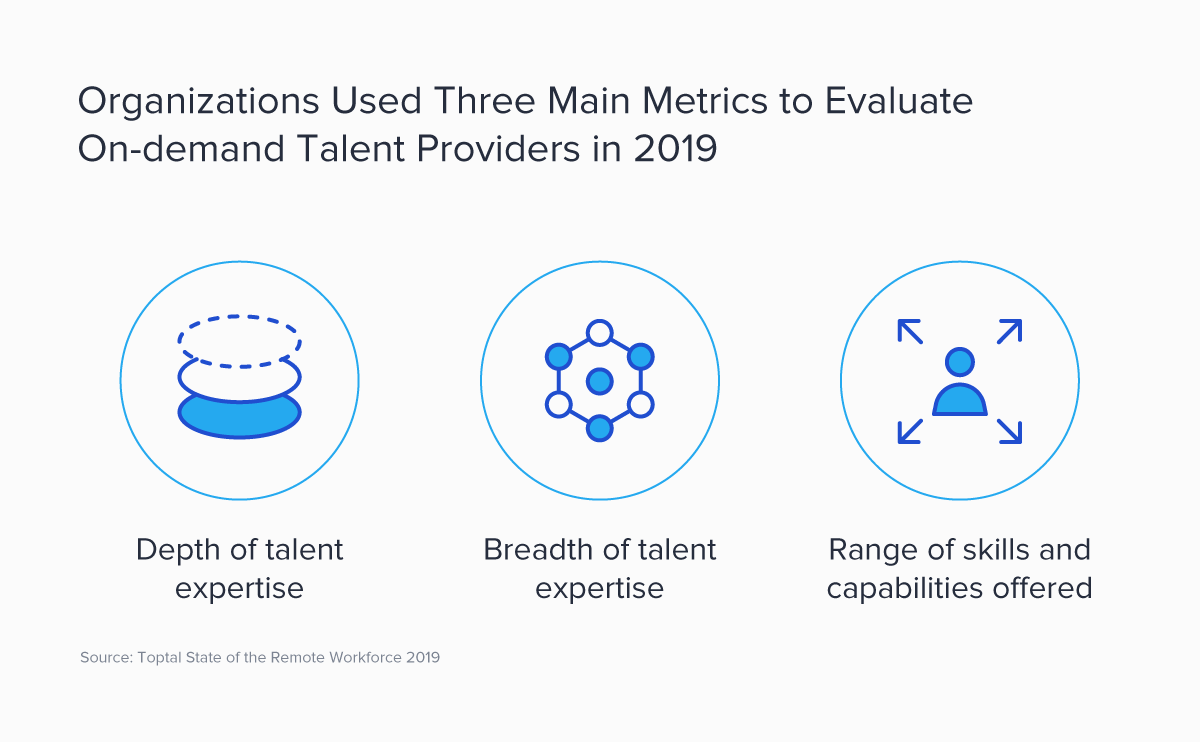
On-demand talent is by definition the highest expertise available remotely, and the associated costs are frequently higher than for contingent or gig talent. Some organizations balk, reasoning that a full-time hire would be cheaper. But there are a few misunderstandings at play here. For one, there may not be a comparable full-time hire available. Second, hiring talent on demand means hiring the very best, and salarying a full-time employee of that caliber might require a pay level much higher than an employer is willing to pay. Third, the burden of cost to an employer should be factored in; a $100k employee’s retainment and benefits cost averages 23% worldwide.
According to the same Toptal report, cost only came in third after quality and experience for the majority of organizations seeking to hire on demand.
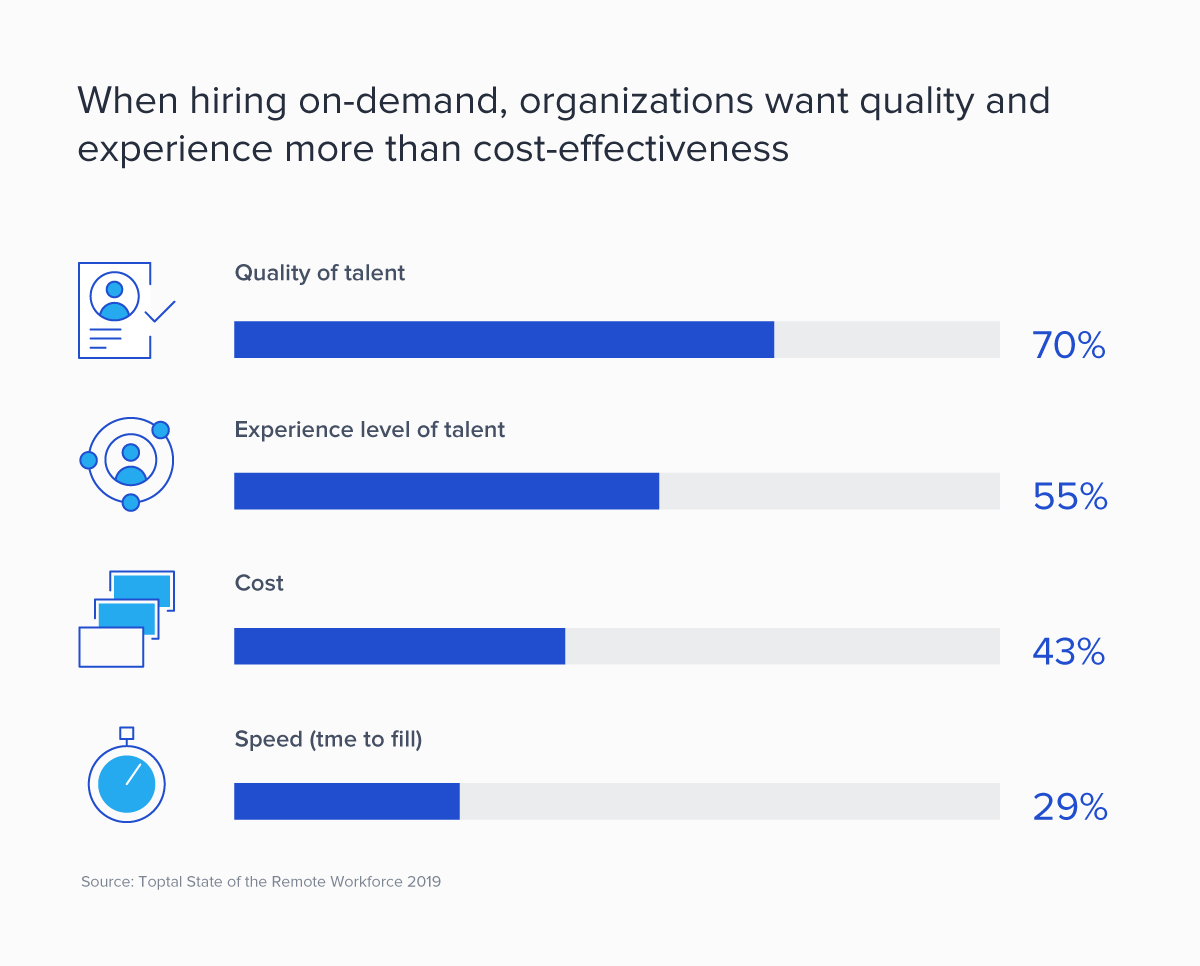
Hiring highly specified experts requires a commensurate investment. It may be that a given project doesn’t need a high level of expertise, in which case the hiring manager should consider a gig or contingent workforce provider instead. But for mission-critical projects that demand expertise, the cost of engagement is well-invested.
Tip #4: Prepare an Infrastructure for On-demand Staffing
Mercer’s 2019 Global Talent Trends report found that 79% of corporate executives “expect contingent and freelance workers to substantially replace full-time employees in the coming years.” Engaging specifically with on-demand talent requires a mindset shift in how teams communicate and collaborate.
The high level of expertise on-demand talent bring to a team needs forethought and support for it to be successfully received. High hopes for an on-demand talent program run the risk of falling flat if there is no infrastructure built into the organization.
Teri Brown, author and enterprise consultant, suggests: “Before creating a strategic plan, look at the goals, values, and culture of your organization and how these relate to hiring a contingent workforce.” Once a broad view of the current and future situation is established, adjustments within the organization can be made to support the shift toward on-demand talent. Here are a few starting points:
- Set clear guidelines. Build a playbook for the entire flow of employment: procurement, hiring, onboarding, statement of work, management, and training.
- Select digital tools. More than ever, it’s easier to support expert on-demand deliverables with remote communication and collaboration. Tools like Slack, Zoom, Trello, and Google Suite make it simple. These tools and programs should be vetted and mapped onto workflows to ensure freelancers can seamlessly understand workflows.
- Establish a training program. With new guidelines and tools in place, success will be determined by how well or poorly they are adopted. Education can be a gamechanger and will help onboard current and future employees into the on-demand model. A forward-thinking approach mitigates potential barriers to productivity.
Moving Toward Expertise
These new styles of collaboration smudge lines drawn by time zones and continents, offering speedy access to services and talent. Now, more than ever, there is a growing opportunity to experiment and integrate gig and on-demand staffing models, design initiatives around them, and reconsider what is possible because of the human cloud.
Organizations are turning toward these new styles of total talent management to solve gaps in available talent and desired expertise, creating a flexible workforce. As the human cloud becomes the norm, the nature of work will transition away from a philosophy built around quantifying and measuring work as it’s performed. The new working philosophy will instead emphasize outcomes, deliverables, and expectations, granting the autonomy for realizing these goals to the talent involved.
By adapting to the human cloud now and experimenting as they grow, companies can prepare themselves for this shift. In doing so, they will build adaptable working models that streamline initiatives and create unprecedented competitive advantages.
